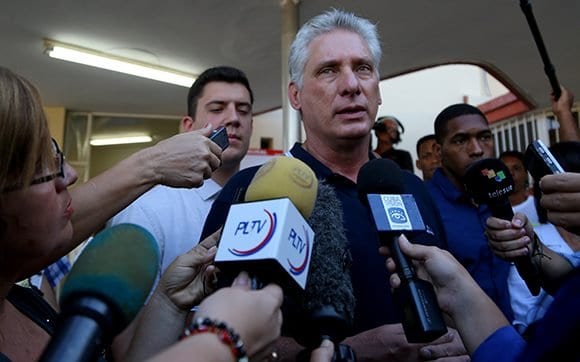Cuba has a New Constitution that was Born Old
By Haroldo Dilla Alfonso

HAVANA TIMES – On February 24th, Cuba’s new Consitution was voted in, and as always in post-revolutionary politics, it was without any surprises and had a predictable outcome. This is the third constitution to be born in the nation’s life as a Republic (ever since 1902), and the second ever since the Revolution triumphed in 1959.
The new Constitution wasn’t as glamorous as its predecessors. It wasn’t announced as the beginning of a new era, but rather as an update with regard to changes in our reality that have been recognized by the ruling elite to be legitimate.
As a result, it has been a weary “constitutional moment”, without the expectations that came with the former two, since 1902. And strangely enough, it’s the first Cuban constitution that hasn’t stemmed from a Revolution or uprising.
The document was written up by an airtight technical committee, which was initially debated by the Cuban Communist Party’s Central Committee and Parliament, and the resulting version was put up for popular consultation at controlled neighborhood meetings.
This discussion served to put on the finishing touches, shoot down the most controversial points that might affect the referendum result (tending to be its most progressive points) and socialize content.
Once this phase ended, it gave way to a two-month period during which people could read the final version and be fueled by an election campaign. Bearing in mind it was a referendum that had two voting options, it would have been fair for both of these to have been published and debated.
However, that didn’t happen: only one campaign was allowed, the vote YES campaign. Negative opinions were banned, and its champions were repressed.
The referendum result:
With such an unfair playing ground, it’s no surprise that the Constitution won overwhelming support. With an electoral register of over 9 million voters, 1.4 million didn’t vote, and out of those who did vote (86%), 4% voted with void or blank ballot papers, and 9% (706,400 people) voted NO. Ultimately, the Constitution was approved by 73% of the possible voting population and by 87% of those who did go to vote. A deliberate political analysis has been made based on these figures.
An initial reaction has been to increase the number of people who didn’t follow the Communist Party’s guideline to vote YES, and believe that 27% of Cubans wanted to reject the Constitution or the system of government it represents. However, this remains an unfortunate confusion of desire with reality.
The results indicate that a vast majority of Cubans aren’t ready to challenge the Cuban Communist Party, even in the solitude of a voting booth. And, nothing indicates that the people who didn’t vote or voted NO, did so because they were repudiating the government. There were many reasons to vote NO, and there are always lots of reasons to abstain.
Catholic and Evangelical churches were against the Constitution because of the small opening that could lead to same-sex marriage, as well as other things. And finally, the percentage of abstention wasn’t any different to levels reported during local and general elections in recent years.
The other reaction has been to magnify approval, with the same deceiving results. Here, the approval figure is lumped together, saying that 86% voted YES. However, over 700,000 people rejected the Constitution explicitly, and this indicates a level of discontent that has never been known in Cuba’s indifferent politics.
Political times are changing and a simple comparison to the referendum carried out in 1976 is enough to underline this difference: back then, 98% of the voting population went to vote and 97.7% voted YES.
If the Cuban political elite has good advisors, some of them should be whispering under their breath and saying that the political landscape is changing and that it will continue to change with financial pressures as a result of Cuba losing its Venezuelan subsidies and the Cuban people’s growing difficulties to emigrate to the US and take refuge in a system that is in favor of their incorporation.
A Constitution for our grandchildren?
We can’t ignore the positive aspects of this constitution. Private enterprise has been given a greater space, rights are better outlined, dual nationality is accepted, as has a more decentralized political framework and decentralized advances which work in local governments’ favor.
However, this is a Constitution crafted in times of the agreement of militarymen and party bureaucrats in 2009, showing signs of new conservative trends in Cuban society. It’s a constitution that is still lagging behind in regard to the constitutions of its Latin American allies, for example.
Thus, it is created in complete contradiction with the maturity of Cuba’s more complex and plural society. It doesn’t solve the problem of democracy (direct elections, pluralism, civil and political rights), or the restrained national problem in the gap between a transnational society such as Cuba’s own and a strictly state sovereign legislation.
In a timeless overflow of joy, newly-appointed president Diaz-Canel assured everyone that a Constitution had been approved for the grandchildren of today’s voters.
I don’t believe that’s a fair forecast. Honestly, Cubans approved a short-term, mediocre Constitution that is distressing for an island that is becoming depopulated in absolute terms, with a stagnant economy and a breakdown of standards and values is taking over everyday behavior. Cuba needed something more daring. I don’t believe that today’s Cubans can wait for their grandchildren to come along.
